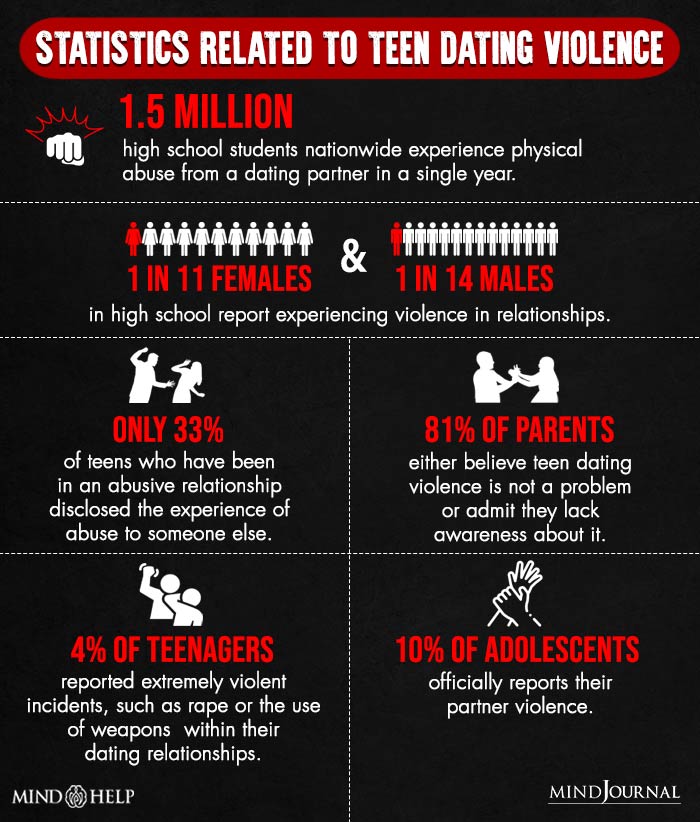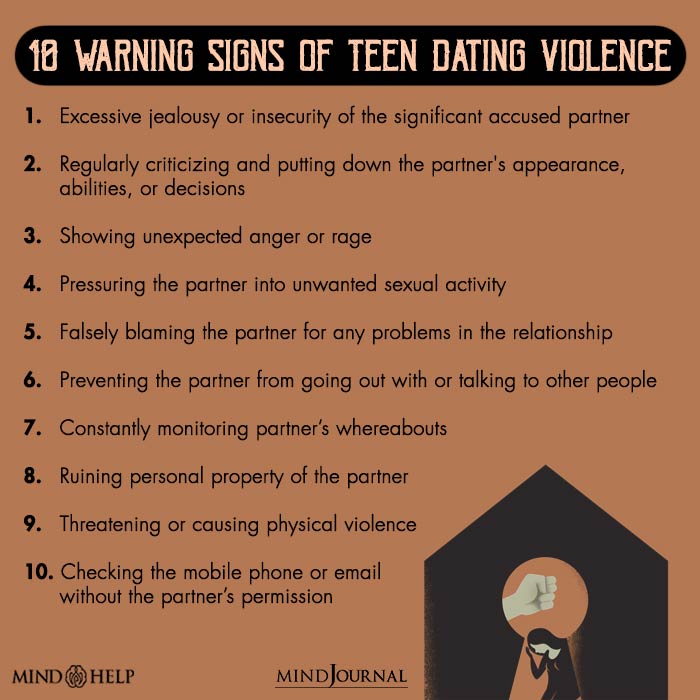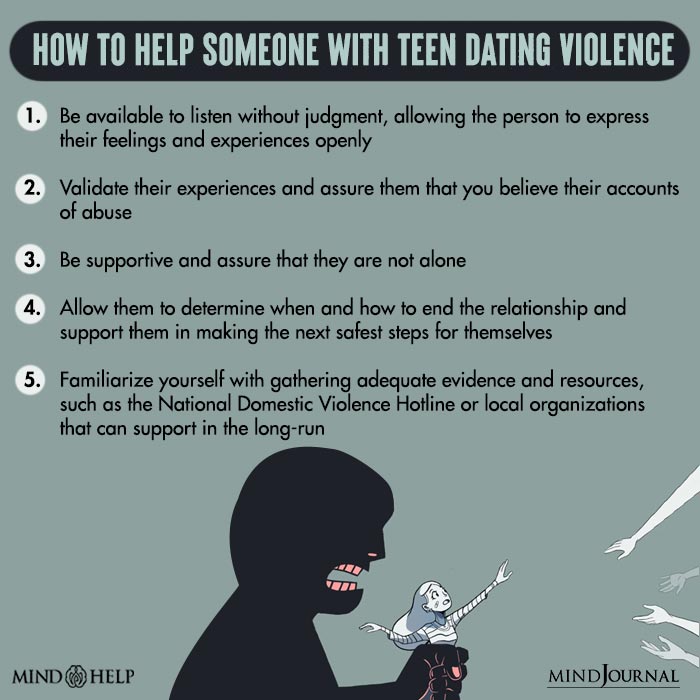Teen dating violence refers to the physical, emotional, or sexual abuse that occurs within a romantic relationship involving teenagers. It is a severe issue that can have long-lasting effects on the victims’ physical and mental well-being.
What is Teen Dating Violence?
Teen dating violence encompasses a pattern of 1 James, W. H., West, C., Deters, K. E., & Armijo, E. (2000). Youth dating violence. Adolescence, 35(139), 455–465. abusive behaviors, characterized by the exertion of power, control, and manipulation to establish dominance over a partner. This destructive phenomenon can take various forms, ranging from subtle acts of control to severe instances of physical or sexual abuse.
The abusive tactics employed in 2 Krahé B. (2021). Teen dating violence: From analyzing the problem to finding solutions. New directions for child and adolescent development, 2021(178), 169–175. https://doi.org/10.1002/cad.20441 teen dating violence encompass a wide spectrum, including physical actions such as hitting, pushing, or slapping, alongside verbal abuse through name-calling, insults, or threats.
Moreover, it involves emotional manipulation, isolating the partner from their support network, monitoring their communication, and imposing unwavering obedience.
The detrimental impact of these behaviors on the victim’s well-being cannot be overstated, resulting in physical injuries, deep emotional trauma, and enduring negative effects on their mental health and future relationships.

Teen Dating Violence and Mental Health
Teen dating violence can result in various mental health 3 Temple, J. R., Choi, H. J., Elmquist, J., Hecht, M., Miller-Day, M., Stuart, G. L., Brem, M., & Wolford-Clevenger, C. (2016). Psychological Abuse, Mental Health, and Acceptance of Dating Violence Among Adolescents. The Journal of adolescent health : official publication of the Society for Adolescent Medicine, 59(2), 197–202. https://doi.org/10.1016/j.jadohealth.2016.03.034 challenges for teenagers, including:
- Anxiety disorder based on the trauma and ongoing fear associated with the abuse can trigger excessive worry, panic attacks, and avoidance behaviors.
- Experiencing major depressive disorder symptoms such as feelings of sadness, hopelessness, and a loss of interest in activities.
- High risk of engaging in self-harming behaviors, such as cutting or burning, and also suicidal thoughts, or engaging in suicidal behaviors.
- Substance abuse to cope with the emotional pain and stress associated with the abusive relationship.
- Symptoms of antisocial behavior such as manipulation, coercion, aggression, and a lack of remorse or empathy.
- Decreased self-esteem and self-worth among teenagers, as they may blame themselves for the abusive behavior.
- Emotional and psychological trauma can manifest as ongoing fear, and difficulty trusting others.

Types of Teen Dating Violence
Teen dating violence can manifest in various forms 4 Pérez-Marco, A., Soares, P., Davó-Blanes, M. C., & Vives-Cases, C. (2020). Identifying Types of Dating Violence and Protective Factors among Adolescents in Spain: A Qualitative Analysis of Lights4Violence Materials. International journal of environmental research and public health, 17(7), 2443. https://doi.org/10.3390/ijerph17072443 , such as:
- Physical abuse- physical acts of aggression such as hitting, slapping, kicking, pushing, or choking. It may also include the use of weapons or objects to cause harm.
- Emotional/Verbal abuse- behaviors that aim to control, manipulate, belittle, or intimidate the partner through verbal attacks, insults, constant criticism, and threats.
- Sexual abuse- any non-consensual sexual activity or pressure for sexual acts, including unwanted touching, forcing, or coercing the partner into sexual acts.
- Digital abuse- this can include spreading rumors, stalking, sharing explicit images on social media without consent, or controlling the partner’s online activities.
- Financial abuse- controlling the partner’s finances or economic resources, such as preventing them from accessing money or withholding funds.
Read More About Emotional Abuse Here
Why Does Teen Dating Violence Happen?
Teen dating violence can have various risk factors 5 Taquette, S. R., & Monteiro, D. L. M. (2019). Causes and consequences of adolescent dating violence: a systematic review. Journal of injury & violence research, 11(2), 137–147. https://doi.org/10.5249/jivr.v11i2.1061 and underlying causes, such as:
- Teenagers who have witnessed or experienced violence in their families or previous relationships.
- Substance abuse, including alcohol and drugs, can impair judgment and increase aggression.
- Teenagers with mental health challenges, such as antisocial behavior or untreated trauma, may be more susceptible to engaging in dating violence.
- Peer groups that engage in violent or controlling behaviors within relationships can influence teenagers to adopt similar patterns.
- Cultural beliefs that prioritize male dominance 6 Taft, A., Hegarty, K., & Flood, M. (2001). Are men and women equally violent to intimate partners?. Australian and New Zealand journal of public health, 25(6), 498–500. https://doi.org/10.1111/j.1467-842x.2001.tb00311.x or reinforce gender stereotypes can also play a role.
Diagnosing Teen Dating Violence
To address the dating violence issue, a healthcare professional 7 Krahé B. (2021). Teen dating violence: From analyzing the problem to finding solutions. New directions for child and adolescent development, 2021(178), 169–175. https://doi.org/10.1002/cad.20441 may:
- Conduct a thorough family history and gather information about the teenager’s dating relationships, including the incidence of control, aggression, or abuse.
- Utilize screening tools to assess 8 Krahé B. (2021). Teen dating violence: From analyzing the problem to finding solutions. New directions for child and adolescent development, 2021(178), 169–175. https://doi.org/10.1002/cad.20441 for dating violence, such as the Dating violence questionnaire (DVQ) or Survey of teen relationships and intimate violence (STRiV).
- Assessing physical injuries, psychological symptoms (e.g., anxiety, depression, PTSD), substance abuse, self-harm behaviors, or any other associated signs and symptoms.
Read More About PTSD Here
Dealing With Teen Dating Violence
Here are some strategies 9 Noonan, R. K., & Charles, D. (2009). Developing teen dating violence prevention strategies: formative research with middle school youth. Violence against women, 15(9), 1087–1105. https://doi.org/10.1177/1077801209340761 for dealing with teen dating violence:
- Learn about the warning signs of teen dating violence, its dynamics, and available resources to empower yourself and make informed decisions.
- Build a support network of trusted friends or family members who can provide emotional support and assistance during your difficult times.
- Keep a record of abusive incidents, including dates, times, and descriptions, as evidence if legal action is needed.
- Consult with a therapist or counselor to address the impacts of teen dating violence and associated mental health symptoms.
- Prioritize self-care activities such as exercise, relaxation techniques, and hobbies to promote physical and emotional well-being.
Read More About Self Care And Wellness Here

Takeaway
Addressing teen dating violence is of utmost importance, requiring a sense of urgency and compassion. Through proactive measures such as raising teen dating violence awareness, providing comprehensive education on healthy relationships, and extending support to those affected, we have the power to create a substantial impact in preventing and ultimately breaking the cycle of this violent behavior.
At A Glance
- Teen dating violence refers to the pattern of abusive behaviors that occur within romantic relationships involving teenagers.
- Teen dating violence can result in various mental health challenges, such as depression, anxiety, antisocial behavior, or substance abuse.
- Teen dating violence can manifest in various forms, such as physical, sexual, emotional, financial, and digital.
- Various risk factors, past experiences, substance abuse, and mental health conditions play crucial roles in teen dating violence.
- A mental health professional diagnoses teen dating violence by gathering information, applying screening tools, and assessing mental health symptoms.
- Raising teen dating violence awareness, providing comprehensive education, and extending support to those affected are crucial for dealing with teen dating violence.
Frequently Asked Questions (FAQs)
1. How can I help a friend who is experiencing teen dating violence?
Providing support such as listening without judgment, expressing concern for their safety, and encouraging them to confess to a trusted adult or seek professional help.
2. How common is teen dating violence?
World Health Organization (WHO) reveals that approximately 29% of adolescent girls worldwide experienced physical or sexual violence in their relationships.
3. What are the warning signs of teen dating violence?
Warning signs may include physical injuries, changes in behavior or mood, isolation from friends and family, declining academic performance, and fear or anxiety about the partner.















